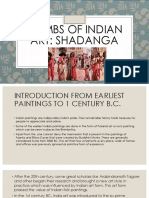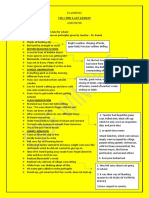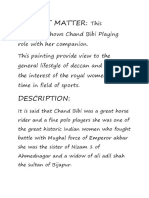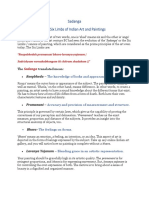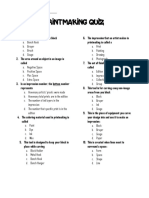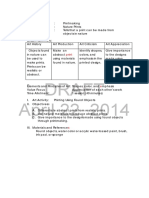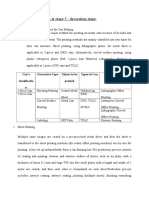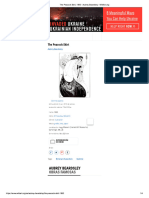Full Notes Graphic Print and Modern Sculpture Class 12
Full Notes Graphic Print and Modern Sculpture Class 12
Uploaded by
corona3d3Copyright:
Available Formats
Full Notes Graphic Print and Modern Sculpture Class 12
Full Notes Graphic Print and Modern Sculpture Class 12
Uploaded by
corona3d3Original Description:
Original Title
Copyright
Available Formats
Share this document
Did you find this document useful?
Is this content inappropriate?
Copyright:
Available Formats
Full Notes Graphic Print and Modern Sculpture Class 12
Full Notes Graphic Print and Modern Sculpture Class 12
Uploaded by
corona3d3Copyright:
Available Formats
CLASS 12 : FINE ARTS
UNIT :3 – GRAPHIC PRINTS & MODERN SCULPTURE
INTRODUCTION OF GRAPHIC PRINT
Printmaking is a process of production of artworks of the original one. Each product print
is not a copy but considered an original artwork. Print making techniques are generally
divided into different categories like Woodcut, Linocuts, Etching and Aquatint, Dry point,
Lithography, Seriography, Mono print, Digital print etc.
WOODCUT AND LINOCUT
It is a type of relief printmaking technique on which artist make the art work and
take the reprint of the same as reverse of the drawing.
Linocut - Woodcut and wood engraving are all types of relief printing processes, in which a
piece of linoleum or block of wood is carved so that the image stands out in relief. The raised
parts that are not cut away are inked with a brayer (a hand-roller) and printed. A sheet of
dampened paper is then placed over the block and firm pressure applied so that the inked
surface is transferred to the paper.
Woodcut - For a woodcut, the wood is sawn along the grain so that it can be carved quite
easily with a knife-like tool. Wood engraving is slightly different and uses end grain wood,
which is very hard. As this is more difficult to cut, the lines are incised into the woodblock
with a sharp metal tool, meaning the image can be much more detailed. Wood engravings are
usually also smaller than woodcuts due to them being restricted to the diameter of the tree
trunk.
ETCHING AND AQUATINT
In etching a metal plate specially zinc plate is processed by nitric acid and use of an
etching needle to create the image on the plate and take the print out by the help of
printing press.
Etching is traditionally the process of using strong acid or mordant to cut into the unprotected
parts of a metal surface to create a design in intaglio (incised) in the metal. Etching has often
been combined with other intaglio techniques such as engraving (e.g., Rembrandt) or aquatint
(e.g., Francisco Goya).
DRY POINT
This is a type of engraving done with a sharp needle and creates the drawing on a
fibre sheet and then the print taken from that fibber sheet through the press.
YOUTUBE :- Study Box By Sagarika
INSTAGRAM :- sagarika.singh_
TELEGRAM :- Studyboxbysagarika
Dry point is a printmaking technique of the intaglio family, in which an image is incised into a
plate (or "matrix") with a hard-pointed "needle" of sharp metal or diamond point. In principle,
the method is practically identical to engraving. The difference is in the use of tools, and that
the raised ridge along the furrow is not scraped or filed away as in engraving. Like etching,
dry point is easier to master than engraving for an artist trained in drawing because the
technique of using the needle is closer to using a pencil than the engraver's burin.
LITHOGRAPHY
The image is drawn on a limestone generally known as “litho stone”; with litho pencil
and glue is applied on. After that stone is formatted in acid and the stone is ready for
print.
Lithography is a method of printing originally based on the immiscibility of oil and water.The
printing is from a stone (lithographic limestone) or a metal plate with a smooth surface. It was
invented in 1796 by the German author and actor Alois Senefelder and was initially used
mostly for musical scores and maps.
SERIOGRAPHY
It creates prints by using a fabric stencil technique. Ink is forced through a fine
screen onto the paper beneath.
Screen printing is a printing technique where a mesh is used to transfer ink onto a substrate,
except in areas made impermeable to the ink by a blocking stencil. A blade or squeegee is
moved across the screen to fill the open mesh apertures with ink, and a reverse stroke then
causes the screen to touch the substrate momentarily along a line of contact. This causes the
ink to wet the substrate and be pulled out of the mesh apertures as the screen springs back
after the blade has passed. One colour is printed at a time, so several screens can be used to
produce a multi-coloured image or design.
MONO PRINT
It is a form of printmaking which creates the impact and impression of print on a
single metrics.
Monoprinting is a type of printmaking where the intent is to make unique prints, that may
explore an image serially. Other methods of printmaking create editioned multiples, the
monoprint is editioned as 1 of 1.
YOUTUBE :- Study Box By Sagarika
INSTAGRAM :- sagarika.singh_
TELEGRAM :- Studyboxbysagarika
GRAPHIC – PRINT PAINTINGS
(VERY IMPORTANT TABLE)
CHILDREN
Artist - Somnath Hore
School - Modern School (Graphic Print)
Medium - Etching and Aquatint (Graphic Print)
Subject Matter - Somnath Hore's monochromatic
etching with aquatint features images of children from
the 1943 Bengal Famine, a lasting impression he left on
his early sketches and drawings. Hore's line drawings
followed representational contours and tonal devices.
Description -
Somnath Hore has created many works representing
hungry children with their mother. This etching also
shows two children with bloated stomach and thin ribs
are shown with liner effect. Their mother is standing
behind them and has put her protective hand on their
shoulder. Suitable tones of mild blue, grey and black
used for the theme of under nurtured children who
YOUTUBE :- Study Box By Sagarika
INSTAGRAM :- sagarika.singh_
TELEGRAM :- Studyboxbysagarika
represent the existence of poor in a depressed society. This graphic print is showing the
human life value of our society
Collection - National Gallery of Modern Art, New Delhi
DEVI
Artist - Jyoti Bhatt
School - Modern School (Graphic Print)
Medium - Etching and Intaglio (Graphic Print)
Subject Matter - Jyoti Bhatt, a 1970s artist, created an
etching on paper based on folk traditions and popular
practices. His works balance space tradition and
modernity, incorporating traditional forms into
contemporary dynamics. The print features Devi's pictorial
image, a woman's frontal face, and folk motifs.
Description -
This print represents the concept of fertility and power
worship as Devi. The form of kundalini encircles the
female fertility power. In the lower section of print provides
an overall frame to the entire composition. Deep etching
within intaglio in black provides an interesting texture to the serpentine form. The forehead
of Devi is decorated with a brilliant vermillion dot. The Devi has wide open eyes is a typical
feature of Durga image of Bengal.
Collection - National Gallery of Modern Art, New Delhi
OFF WALL
Artist - Anupam Sood
School - Modern School (Graphic Print)
Medium - Lithography (Graphic Print)
Subject Matter - Anupam Sud, a printmaker from India, created an etching in 1982 from
zinc plate and paper, focusing on social problems faced by marginalized communities and
artistic understanding of their reality.
YOUTUBE :- Study Box By Sagarika
INSTAGRAM :- sagarika.singh_
TELEGRAM :- Studyboxbysagarika
Description –
Anupam Sood used her perfect craftsmanship
and understanding of anatomy to create
composition in which figures are playing a
prominent role. Off Wall is a lithograph print
taken by the help of the limestone in which a
woman form is sitting under a wall and on the
foreground a male lower limb has been drawn.
This print is showing the humanity, emotions,
life value and internal feeling of human being.
The wall is printed in brown colour and line
drawing of folk paintings is drawn in the wall
in white colour.
Collection - National Gallery of Modern Art, New Delhi
MAN, WOMAN AND TREE
Artist - K. Laxma Goud
School - Modern School (Graphic Print)
Medium - Lithography (Graphic Print)
Subject Matter – K. Laxman Goud, influenced by
visual traditions, classical, folk, and popular cultures,
blurred lines between major and minor arts, allowing
him to explore mediums like glass painting,
terracotta, and bronze.
Description -
This vertical graphic print is having four trees in
background. While in the foreground on left side a
woman is sitting under the tree wearing a nose ring
and a necklace. She is looking towards the man, who
is opposite to her appearing under the trees and
looking at her. light blue and green colours are used
to create this print. Green coloured bushes are drawn at the front of the composition.
Collection - National Gallery of Modern Art, New Delhi
YOUTUBE :- Study Box By Sagarika
INSTAGRAM :- sagarika.singh_
TELEGRAM :- Studyboxbysagarika
MODERN SCULPTURE
MODERN SCULPTURE PAINTINGS
(VERY IMPORATNT TABLE)
TRIUMPH OF LABOUR
Artist – D.P. Rai Chowdhury
School - Modern School (Sculpture)
Medium - Bronze and Cement (Modern Sculpture)
Subject Matter - It shows four men trying to move a rock, rendering the importance and
contribution of human labour in nation building. The image of group labour is placed on a
high pedestal, thereby, replacing the notion of portraits of kings or British dignitaries
YOUTUBE :- Study Box By Sagarika
INSTAGRAM :- sagarika.singh_
TELEGRAM :- Studyboxbysagarika
Description -
This is sculpture is displayed in front of
the National Gallery of Modern Art and
can be seen by passing through main road
of India Gate. In this sculpture four
labours are engaged in a task of moving a
block of stone with the help of wooden
logs. All the labours are wearing only loin
cloths and two of them have covered their
heads with a piece of cloth. These labours
are working in a hilly area. Through this
sculpture the artist has conveyed the idea
of united efforts that can move any
blockade. This sculpture is showing the
human life values.
Collection - National Gallery of Modern Art, New Delhi
SANTHAL FAMILY
Artist – Ramkinkar Baij
School - Modern School (Sculpture)
Medium - Cement and Concrete (Modern Sculpture)
Subject Matter - The significance of this work is that it is
regarded as the first public modernist sculpture in India
which speaks of the family migrating from one region to
another, carrying all their frugal possessions. (The
material of which it is made of is important. The artist has
avoided traditional medium like marble, wood or stone, and
has preferred cement, the symbol of modernisation.)
Description -
Rough textured group of Santhal Family with its multiple
figures and strong movement is shown in this sculpture.
In this composition a male and a female figure is standing
side by side with walking action. a dog with them and a child is seating on a front side
basket hanging from the balancing rod. The backside basket of the balancing rod is filled
with some household material. The female is walking beside the man has carried the load
on her head and carried her child in her left waist. It is an entire family in migration. This
roadside sculpture is placed on a rough textured land of Santiniketan and made with
graves, cement and red clay of that area which are easily available.
Collection – Viswa Bharati, Santiniketan, West Bengal
YOUTUBE :- Study Box By Sagarika
INSTAGRAM :- sagarika.singh_
TELEGRAM :- Studyboxbysagarika
CRIES UNHEARD
Artist – Amarnath Sehgal
School - Modern School (Sculpture)
Medium - Bronze (Modern Sculpture)
Subject Matter - Amarnath Sahgal's 1958 bronze sculpture
features three stick-like figures in flat rhythmical planes,
resembling a family. The work can be seen as socialist,
paying homage to millions of destitute families whose cries
are ignored, highlighting their need for help.
Description -
There are three standing figure of a family with their gloomy
faces showing agony and distress. Man, woman and a child
stand with their hands raised upwards. these figures are
simplified and almost primitive simplicity gives an element of
strength to this sculpture. The sculpture has suggested the
cries op suffering human by making hollowness in their
heads. Made mask like faces keep appearing again and again
in the sculpture of Amarnath Sehgal, which is showing the human life values.
Collection - National Gallery of Modern Art, New Delhi
GANESHA
Artist – P.V. Janakiram
School - Modern School (Sculpture)
Medium – Wire, Tin, Oxidised Copper (Modern Sculpture)
Subject Matter - P. V. Janakiram's 1970 oxidised copper
sculpture features linear silhouettes, rhythm, growth, and
lyrical stylisation, blending folk and traditional
craftsmanship, despite its volume and focus on linearity.
Description -
This sculpture of Ganesha is made of metal, tin and copper
wire. In this sculpture Ganesha is in dancing posture. His left
foot is down and right is folded near the knee of left leg. He is
holding a Lotus bud in his right upper hand. The upper left
hand he is holding an engraver and he is playing a veena by his other two hands. Mostly
the sculpture is completed different designs of wire.
Collection - National Gallery of Modern Art, New Delhi
YOUTUBE :- Study Box By Sagarika
INSTAGRAM :- sagarika.singh_
TELEGRAM :- Studyboxbysagarika
You might also like
- N.Rosenblum Parcial.p.1a178 PDFDocument178 pagesN.Rosenblum Parcial.p.1a178 PDFGabriela Barzaghi De Laurentiis100% (1)
- Xii Painting Objective QuestionDocument6 pagesXii Painting Objective QuestionHitesh Ruhal100% (1)
- 6 Limbs of Indian Art: ShadangaDocument10 pages6 Limbs of Indian Art: ShadangaShivam Aggarwal67% (3)
- Composition: The Anatomy of Picture MakingFrom EverandComposition: The Anatomy of Picture MakingRating: 3.5 out of 5 stars3.5/5 (3)
- Full Notes Bengal School Class 12Document6 pagesFull Notes Bengal School Class 12anonymousstillerNo ratings yet
- The Contribution of Indian Artists in The Struggle For National Freedom MovementDocument5 pagesThe Contribution of Indian Artists in The Struggle For National Freedom MovementAnant Gupta100% (1)
- Class 12: Fine Arts Unit: 3 - National Flag of India & Its Symbolic SignificanceDocument2 pagesClass 12: Fine Arts Unit: 3 - National Flag of India & Its Symbolic SignificanceHitesh Kumar100% (1)
- Test Paper Class 12 Fine ArtDocument5 pagesTest Paper Class 12 Fine ArtheraanganingNo ratings yet
- The Bengal School of Painting: Origin and Development 1Document6 pagesThe Bengal School of Painting: Origin and Development 1Tanishq AryanNo ratings yet
- The Rajasthani School Q&A 23-24Document6 pagesThe Rajasthani School Q&A 23-24Legend GamingNo ratings yet
- English Revision Notes XIIDocument41 pagesEnglish Revision Notes XIIRämíz MêmóñNo ratings yet
- Full Notes Modern School Class 12Document6 pagesFull Notes Modern School Class 12n79970295No ratings yet
- Sample Question Paper Applied Arts (SUBJECT CODE-052) CLASS XII (SESSION 2021-2022) Term - 1Document4 pagesSample Question Paper Applied Arts (SUBJECT CODE-052) CLASS XII (SESSION 2021-2022) Term - 1Aaløk ßhaskarNo ratings yet
- PDF 12th NotesDocument31 pagesPDF 12th NotesXndrcage Bravestone100% (3)
- Origin, Development and Main Features of The Bengal School of PaintingDocument6 pagesOrigin, Development and Main Features of The Bengal School of Painting18ufaa044 18ufaa044No ratings yet
- Sculptures of Modern Trends in Indian ArtDocument7 pagesSculptures of Modern Trends in Indian ArtAnupama Rawat100% (2)
- Grade 11 - Chapter 6 - The Art During Mauryan, Shunga, Kushana and Gupta PeriodsDocument12 pagesGrade 11 - Chapter 6 - The Art During Mauryan, Shunga, Kushana and Gupta PeriodsmonicabNo ratings yet
- Chand Bibi Playing PoloDocument4 pagesChand Bibi Playing Polovivek33% (3)
- Applied Arts SQPDocument8 pagesApplied Arts SQPNavya AgarwalNo ratings yet
- History of Indian Art - 12Document72 pagesHistory of Indian Art - 12panditpirodevNo ratings yet
- The Rajasthani School of Miniature PaintingDocument3 pagesThe Rajasthani School of Miniature PaintingSamman Gupta50% (2)
- The Pahari School Q&A 23-24Document5 pagesThe Pahari School Q&A 23-24Legend GamingNo ratings yet
- Class 12 Complete Book of Fine Art An Introduction To Indian Art 2 English PDFDocument164 pagesClass 12 Complete Book of Fine Art An Introduction To Indian Art 2 English PDFSTUDY FOR JEE100% (2)
- The Deccan School of Miniature PaintingDocument4 pagesThe Deccan School of Miniature PaintingSamman Gupta0% (1)
- Sample Question Paper Sculpture (Subject Code-051) CLASS XII (SESSION 2021-2022) Term - 1 Ax. Time Allowed: 60 Minutes (1Hrs.) Max. Marks: 15Document4 pagesSample Question Paper Sculpture (Subject Code-051) CLASS XII (SESSION 2021-2022) Term - 1 Ax. Time Allowed: 60 Minutes (1Hrs.) Max. Marks: 15League YTNo ratings yet
- Ch.03. Q. The Mughal School of Miniature PaintingsDocument2 pagesCh.03. Q. The Mughal School of Miniature PaintingsSamman Gupta50% (2)
- Full Notes Deccan School Class 12Document5 pagesFull Notes Deccan School Class 12Hitesh Kumar100% (2)
- Class - Xii - Painting and Sculpture - Study of Pahari Painting - WS - 5 - 2020Document4 pagesClass - Xii - Painting and Sculpture - Study of Pahari Painting - WS - 5 - 2020Davio Danger100% (1)
- UNIT-1 History of Indian Art The Rajasthani School of Miniature Painting Origin and DevelopmentDocument10 pagesUNIT-1 History of Indian Art The Rajasthani School of Miniature Painting Origin and DevelopmentWaterNo ratings yet
- Painting-PREVIOUSE YEAR SAMPLE PAPER 2023-24Document34 pagesPainting-PREVIOUSE YEAR SAMPLE PAPER 2023-24New Era Senior Secondary SchoolNo ratings yet
- Mughal and Rajasthani SchoolsDocument2 pagesMughal and Rajasthani SchoolsVAIBHAV AGRAWALNo ratings yet
- Class Xii Fine Art's Notes Unit 1 Rajasthani School of Miniature RaingtingDocument14 pagesClass Xii Fine Art's Notes Unit 1 Rajasthani School of Miniature RaingtingPriyanshu Guptq100% (1)
- 'FINE ARTS' NOTES & Syllabous PDFDocument29 pages'FINE ARTS' NOTES & Syllabous PDFShrey GoelNo ratings yet
- New Painting Cbse Class 12 of Fine ArtsDocument12 pagesNew Painting Cbse Class 12 of Fine ArtsRupesh50% (4)
- Full Notes Mughal School Class 12Document8 pagesFull Notes Mughal School Class 12Hitesh KumarNo ratings yet
- Bengal SchoolDocument24 pagesBengal SchoolRAHUL16398No ratings yet
- 12th Mughal Miniature PaintngDocument34 pages12th Mughal Miniature PaintngHarshita Kaur100% (2)
- Introduction - Origin and Development - Sub-Schools - Mewar, Bondi, Jodhpur, Bikaner, Kishangarh, Jaipur - PantingsDocument12 pagesIntroduction - Origin and Development - Sub-Schools - Mewar, Bondi, Jodhpur, Bikaner, Kishangarh, Jaipur - PantingsAnupama RawatNo ratings yet
- The Pahari School of MiniaturepaintingDocument3 pagesThe Pahari School of MiniaturepaintingSamman GuptaNo ratings yet
- Deccan School of Miniature Painting XiiDocument10 pagesDeccan School of Miniature Painting XiiAnupama Rawat50% (2)
- Artistic Aspects of Indian Temple Architecture 21-22Document33 pagesArtistic Aspects of Indian Temple Architecture 21-22ruhita directionerNo ratings yet
- Painting & GraphicsDocument4 pagesPainting & GraphicsSrijani MondalNo ratings yet
- A Text Book of Fine ArtsDocument41 pagesA Text Book of Fine Artskushalx1316No ratings yet
- Class - 12th Chapter - 03 The Mughal School of Miniature PaintingDocument11 pagesClass - 12th Chapter - 03 The Mughal School of Miniature PaintingN-I-K-I-T-A100% (2)
- 11 Painting - Six Limbs of Art - Notes and Video LinkDocument2 pages11 Painting - Six Limbs of Art - Notes and Video LinkKamal Jajoriya100% (1)
- Question Bank - CommDocument2 pagesQuestion Bank - Commmonika singh100% (1)
- The Mughal School of PaintingDocument2 pagesThe Mughal School of PaintingShashi KumarNo ratings yet
- Ch.6. Q. & Ans. of Introduction To The Bengal School of PaintingDocument10 pagesCh.6. Q. & Ans. of Introduction To The Bengal School of PaintingSamman Gupta100% (1)
- 'Fine Arts' NotesDocument28 pages'Fine Arts' NotesUtkarsh Verma100% (2)
- Class Xii Painting Evolution of Indian National Flag Ws 13 2020Document2 pagesClass Xii Painting Evolution of Indian National Flag Ws 13 2020Ajit HuidromNo ratings yet
- Mughal School of Miniature Paintings: 16 Century A.D. To 19 Century A.DDocument17 pagesMughal School of Miniature Paintings: 16 Century A.D. To 19 Century A.DAnshika Goel67% (3)
- The Asian School, Dehradun Multiple Choice Questions 2019: Painting Class - Xii Chapter-12Document2 pagesThe Asian School, Dehradun Multiple Choice Questions 2019: Painting Class - Xii Chapter-12Gaurav KumarNo ratings yet
- 12th Deccani Miniature PaintingDocument25 pages12th Deccani Miniature Paintingsandy BoiNo ratings yet
- 12th Pahari MiniatureDocument20 pages12th Pahari Miniaturesandy BoiNo ratings yet
- 12th Rajasthani Miniature PaintingDocument34 pages12th Rajasthani Miniature PaintingHarshita Kaur100% (2)
- 11 Painting - Fundamentals of Visual Art - Notes and Video LinkDocument4 pages11 Painting - Fundamentals of Visual Art - Notes and Video Linksneha0% (1)
- Class Xii Fine Arts Rajasthani Miniature Painting Worksheet 2Document2 pagesClass Xii Fine Arts Rajasthani Miniature Painting Worksheet 2Renu Devi100% (1)
- Document Polarisation of LightDocument9 pagesDocument Polarisation of LightKunal KashyapNo ratings yet
- Drawing, Painting, and 2-D ArtDocument58 pagesDrawing, Painting, and 2-D ArtSk.Abdul NaveedNo ratings yet
- Artistic Skills and Techniques To Contemporary Art CreationDocument26 pagesArtistic Skills and Techniques To Contemporary Art CreationYAni Berminocsal91% (32)
- Contemporary Arts LectureDocument12 pagesContemporary Arts Lecturemomo momoNo ratings yet
- Different Contemporary Art Techniques and PerformanceDocument30 pagesDifferent Contemporary Art Techniques and PerformanceAoi BaraNo ratings yet
- Ge 7 - Module Week 1 - 3 PDFDocument32 pagesGe 7 - Module Week 1 - 3 PDFRerey ValesNo ratings yet
- DLL - Mapeh-Arts 6 - Q3 - W3Document5 pagesDLL - Mapeh-Arts 6 - Q3 - W3Annelyn AmparadoNo ratings yet
- Flexo vs. Other Printing MethodsDocument12 pagesFlexo vs. Other Printing MethodsMaster Puskyn100% (1)
- Francisco Goya: Francisco José de Goya y Lucientes Is An Innovative Spanish Painter and EtcherDocument5 pagesFrancisco Goya: Francisco José de Goya y Lucientes Is An Innovative Spanish Painter and Etcherdani_dani471No ratings yet
- IB Visual Arts GlossaryDocument13 pagesIB Visual Arts Glossarylisa mckeneyNo ratings yet
- ArtNews July August 2018Document6 pagesArtNews July August 2018SLOMuseumofArt100% (1)
- Humanities of ManDocument154 pagesHumanities of Manwilly mendozaNo ratings yet
- The LanguageLab Library - The Visual Dictionary of Illustration PDFDocument290 pagesThe LanguageLab Library - The Visual Dictionary of Illustration PDFYorvin J. Aguilar100% (4)
- Art Winter 2011.BDDocument60 pagesArt Winter 2011.BDOlga BarbarasaNo ratings yet
- ARTS 3430 Printmaking: Serigraphy 3 Credit Hours/ 9 Studio HoursDocument4 pagesARTS 3430 Printmaking: Serigraphy 3 Credit Hours/ 9 Studio Hoursapi-228554027No ratings yet
- Imagery On Fabric A Complete Surface Design Handbook PDFDocument180 pagesImagery On Fabric A Complete Surface Design Handbook PDFAliceCotovioNo ratings yet
- Natural Forms WK (1) Task SheetDocument6 pagesNatural Forms WK (1) Task Sheetapi-252776499100% (1)
- Durer Presentation NotesDocument12 pagesDurer Presentation NotesMIchaelNo ratings yet
- Printmaking QuizDocument2 pagesPrintmaking QuizWilma S. MabagNo ratings yet
- TG - Art 3 - Q3Document26 pagesTG - Art 3 - Q3LouieNo ratings yet
- Investigation and Testing To Develop An Infill Formula Suitable For Oil Painting On CopperDocument33 pagesInvestigation and Testing To Develop An Infill Formula Suitable For Oil Painting On Copperdaesvega100% (1)
- arts100_v9_wk2_visual_arts_scavenger_hunt_matrix fib(1)Document3 pagesarts100_v9_wk2_visual_arts_scavenger_hunt_matrix fib(1)kavthegreat13No ratings yet
- Ss 2 Visual Art 3rd Term ExamDocument6 pagesSs 2 Visual Art 3rd Term Exampraiseosifoforever90No ratings yet
- Brochure 10 OCA FinalDocument12 pagesBrochure 10 OCA FinalPaul VincentNo ratings yet
- Art Curriculum Guide Grades 1-10 Final As of 01-17-2016Document93 pagesArt Curriculum Guide Grades 1-10 Final As of 01-17-2016Vhannie Acquiatan100% (5)
- Hind (Ed) - Marcantonio and Italian Engravers and Etchers of The Sixteenth - CenturyDocument152 pagesHind (Ed) - Marcantonio and Italian Engravers and Etchers of The Sixteenth - CenturyfmurphNo ratings yet
- Further Information at Stage 5Document3 pagesFurther Information at Stage 5cuteyaya24No ratings yet
- Reviewer Medium and Techniques - 020958Document16 pagesReviewer Medium and Techniques - 020958floramaynavanes92No ratings yet
- Arts 3 LM DRAFT 4.10.2014Document97 pagesArts 3 LM DRAFT 4.10.2014catherinerenanteNo ratings yet
- Art and ArtisansDocument8 pagesArt and ArtisansJeyl LapuzNo ratings yet
- IMPOSSIBLE Polaroid 8x10 Creative TechniquesDocument19 pagesIMPOSSIBLE Polaroid 8x10 Creative Techniquesdragosandriana100% (1)
- The Peacock Skirt, 1893 - Aubrey Beardsley - WikiArtDocument4 pagesThe Peacock Skirt, 1893 - Aubrey Beardsley - WikiArtDa OpNo ratings yet
- Budget of Work ART5Document2 pagesBudget of Work ART5oranisouthNo ratings yet


